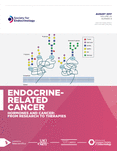Preclinical progress and first translational steps for a liposomal chemotherapy protocol against adrenocortical carcinoma
- Sara Jung1,
- Zoltan Nagy2,
- Martin Fassnacht3,4,
- Gerard Zambetti5,
- Max Weiss6,
- Martin Reincke1,
- Peter Igaz2,
- Felix Beuschlein1 and
- Constanze Hantel1⇑
- 1Endocrine Research Unit, Medizinische Klinik und Poliklinik IV, Ludwig-Maximilians-University, Munich, Germany
- 22nd Department of Medicine, Semmelweis University, Faculty of Medicine, Budapest, Hungary
- 3Department of Internal Medicine I, Division of Endocrinology and Diabetes, University Hospital, University of Würzburg, Würzburg, Germany
- 4Comprehensive Cancer Center Mainfranken, University of Würzburg, Würzburg, Germany
- 5Department of Pathology, St Jude Children’s Research Hospital, Memphis, Tennessee, USA
- 6Institute of Pathology, Ludwig-Maximilians-University, Munich, Germany
- Correspondence should be addressed to C Hantel; Email: Constanze.Hantel{at}med.uni-muenchen.de
Abstract
Systemic therapy of adrenocortical carcinoma (ACC) is limited by heterogeneous tumor response and adverse effects. Recently, we demonstrated anti-tumor activity of LEDP-M (etoposide, liposomal doxorubicin, liposomal cisplatin, mitotane), a liposomal variant of EDP-M (etoposide, doxorubicin, cisplatin, mitotane). To improve the therapeutic efficacy and off-target profiles of the clinical gold standard EDP-M, we investigated liposomal EDP-M regimens in different preclinical settings and in a small number of ACC patients with very advanced disease. Short- and long-term experiments were performed on two ACC models (SW-13 and SJ-ACC3) in vivo. We evaluated the anti-tumoral effects and off-target profiles of EDP-M, LEDP-M and a novel regimen L(l)EDP-M including liposomal etoposide. Furthermore, the role of plasma microRNA-210 as a therapeutic biomarker and first clinical data were assessed. Classical and liposomal protocols revealed anti-proliferative efficacy against SW-13 (EDP-M P < 0.01; LEDP-M: P < 0.001; L(l)EDP-M: P < 0.001 vs controls), whereas in SJ-ACC3, only EDP-M (P < 0.05 vs controls) was slightly effective. Long-term experiments in SW-13 demonstrated anti-tumor efficacy for all treatment schemes (EDP-M: P < 0.01, LEDP-M: P < 0.05, L(l)EDP-M P < 0.001 vs controls). The analysis of pre-defined criteria leading to study termination revealed significant differences for control (P < 0.0001) and EDP-M (P = 0.003) compared to L(l)EDP-M treatment. Raising its potential for therapy monitoring, we detected elevated levels of circulating microRNA-210 in SW-13 after LEDP-M treatment (P < 0.05). In contrast, no comparable effects were detectable for SJ-ACC3. However, overall histological evaluation demonstrated improved off-target profiles following liposomal regimens. The first clinical data indicate improved tolerability of liposomal EDP-M, thus confirming our results. In summary, liposomal EDP-M regimens represent promising treatment options to improve clinical treatment of ACC.
- adrenocortical carcinoma
- liposomal doxorubicin
- liposomal cisplatin
- liposomal etoposide
- Caelyx
- Lipoplatin
- Myocet
- NCI-H295R
- SJ-ACC3
- SW-13
- microRNA-210
- microRNA-483-5p
- Received 18 August 2016
- Accepted 22 August 2016
- Made available online as an Accepted Preprint 22 August 2016
- © 2016 Society for Endocrinology












